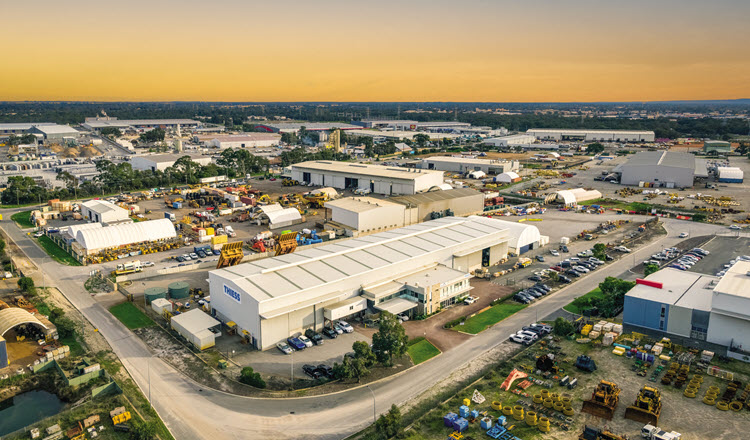You are now leaving Centuria Australia
and entering Centuria New Zealand.
When it comes to investing in real estate, Australian investors have a strong preference for residential property. Home ownership is a familiar concept to most people and it is perceived to be relatively simple and more affordable than commercial property. While residential property has its merits, this bias may cause many investors to overlook the attractive opportunities that investing in commercial real estate can offer.
A diversified portfolio that includes commercial real estate can provide significant advantages in terms of income potential, risk diversification and overall portfolio resilience. Let’s take a closer look at the key benefits of investing in commercial real estate that investors may miss by focusing exclusively on the residential market.
One of the primary advantages of commercial real estate is its potential for higher income returns compared to residential investment properties.
Commercial properties, such as industrial warehouses, office buildings and retail spaces, typically offer higher rental yields. This is partly due to longer lease terms that generally feature fixed annual rental increases of between 3.0% and 4.0% and can range from five to ten years or more, providing a stable and predictable income stream. In contrast, residential leases are usually much shorter, often one year, leading to higher tenant turnover and potentially more vacancies.
Additionally, commercial tenants are often responsible for property expenses, such as maintenance, insurance and taxes, through triple net leases. This arrangement reduces the landlord’s operating costs and increases net income, making commercial real estate a more attractive option for investors seeking a steady cash flow.

Investing in commercial properties allows for diversification across different sectors such as office, retail, industrial and social infrastructure.
Each sector responds differently to economic cycles, which can help mitigate overall investment risk. Commercial properties are also often located in diverse geographic regions, from city centres to suburban areas, providing further diversification benefits.
While residential properties can be spread across different locations, they generally belong to the same asset class, making it harder to achieve the same level of diversification as commercial properties.
Whilst residential property can always be renovated or improved, commercial real estate may offer more opportunities for investment in the property in order to drive value appreciation.
Investors can enhance the value of commercial properties through strategic improvements, such as renovating office spaces, upgrading building infrastructure, or repurposing properties to meet changing market demands. These improvements can attract higher-quality tenants, increase rental rates and ultimately this may boost the property’s market value.
Furthermore, commercial properties are often valued based on their income-generating potential, using metrics such as capitalisation rates (cap rates). By increasing a property’s net operating income, investors can best position a property to for improved capital value.

Investors in unlisted commercial real estate funds can take advantage of tax deferred distributions.
Tax deferred distributions are generally not taxed when received. Rather, they reduce the cost base of an investor’s units in the trust/fund. However, if the cost base of the units is reduced to nil, capital gains may arise to the extent of any excess tax deferred distributions. This strategy can be particularly powerful for long term investors, as it enables them to reinvest their income without immediate tax consequences.
Another tax benefit of investing in commercial property is the ability to claim GST credits. Commercial property funds registered for GST can claim back GST paid on property related expenses, such as repairs and maintenance. In contrast, GST credits cannot be claimed on any expenses incurred in connection with the leasing of residential properties.

Commercial real estate can serve as an effective hedge against inflation, although this does depend on the level of debt.
As inflation rises, the cost of goods and services increases, which often leads to less building being built and higher rents. Commercial leases also frequently include escalation clauses that adjust rental rates in line with inflation, ensuring that the property’s income keeps pace with rising costs. This ability to pass on inflation-related increases to tenants helps protect the real value of the investment and maintain purchasing power over time.
It is important to note however, that level of debt used to acquire an asset may offset some of this inflationary hedge as interest rates will generally be higher in periods of higher inflation.
In contrast, residential leases may not have the same flexibility to adjust rents as frequently, particularly in markets with tight rent control regulations. This limitation can erode the real returns from residential property investments during periods of high inflation.

Residential property investors, particularly those with smaller portfolios, may find themselves involved in managing tenants, handling repairs and addressing regulatory compliance issues.
Investing in commercial real estate, however, often involves working with professional property management companies, which can be a significant advantage for investors who prefer a more hands-off approach. Although it adds to the cost of owning a commercial property, these management companies take care of the day-to-day operations, tenant relations and maintenance, allowing investors to reduce the minutiae of property management.
An even more streamlined and efficient investment experience can be achieved by investing in an unlisted commercial property fund. These funds are managed by professional fund managers with expertise in property selection, acquisition, management and disposal. This professional oversight can enhance the performance of the fund. Other key benefits include access to high-quality assets with lower entry points, sometimes as low as $10,000.
While residential property investment is likely to remain a popular choice, it is important for investors to recognise the unique benefits that commercial real estate can offer. Higher income potential, risk diversification, value-add opportunities, tax advantages, inflation protection and professional management are compelling reasons to consider including commercial properties in an investment portfolio.
By overlooking commercial real estate as an investment choice, investors may miss out on the potential to enhance their returns and build a more robust, resilient portfolio. Embracing a diversified investment strategy that includes both residential and commercial real estate may lead to greater financial stability and long-term wealth creation.
Please complete the form to register your interest in receiving updates on future unlisted property fund opportunities.